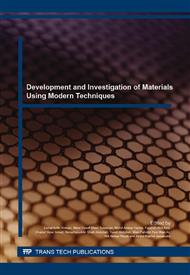p.71
p.77
p.82
p.87
p.91
p.97
p.103
p.108
p.112
Mechanical and Morphological Properties of Meranti Wood Flour Filled Polypropylene Composites
Abstract:
Wood plastic composites (WPC) have been produced by compounding meranti wood flour (WF) with polypropylene (PP) copolymer using a twin-screw extruder. The meranti WF content was varied from 30 to 60 wt.%. The mechanical properties, i.e. tensile, flexural and impact of the composites were determined on injection-molded specimens. The tensile fractured surfaces were used to study the morphological properties of the composites. The result shows that the increment in WF content has given a significant improvement in modulus properties but at the expense of strength and toughness properties. A commercial maleic anhydride grafted polypropylene (MAPP) compatibilizer at 5 wt.% was incorporated into the PP40/WF60 formulation. The strength, stiffness and toughness properties were improved significantly in the presence of MAPP. The morphology of the composites was studied by scanning electron microscopy (SEM). The improvement of the fibre-matrix adhesion between the WF and PP matrix as revealed by SEM is believed to be one of the major reasons for the improved mechanical properties.
Info:
Periodical:
Pages:
91-96
Citation:
Online since:
January 2016
Keywords:
Price:
Сopyright:
© 2016 Trans Tech Publications Ltd. All Rights Reserved
Share:
Citation:


